
Map of religion in africa but i have no data (includes data for both sudans and chad) r
A map showing religious distribution in Africa. While Africans profess a wide variety of religious beliefs, the majority of the people respect African religions or parts of them. However, in formal surveys or census, most people will identify with major religions that came from outside the continent, mainly through colonisation.
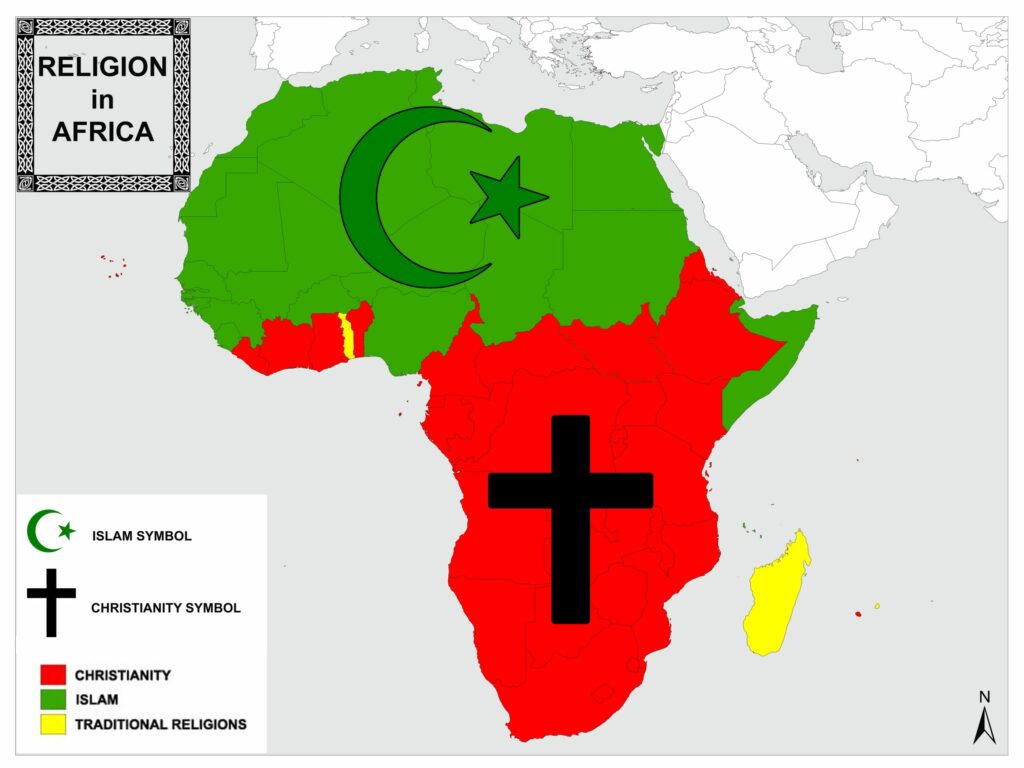
Religions in Africa Mappr
Previously, we brought you "11 Maps to Help You Make Sense of World Religion," "13 Insightful Maps of U.S. Religion," and "10 Revealing Maps of Religion in Europe."We even brought you "24 Crazy Facts About Global Christianity in the 21st Century"! Today, we're zeroing in on that great place of exponential growth in the Christian faith: Africa.

Tout savoir sur la Carte des religions en Afrique Cotedivoire.News
The introduced religions of Islam (in northern Africa) and Christianity (in southern Africa) are now the continent's major religions, but traditional religions still play an important role, especially in the interior of sub-Saharan Africa. The numerous traditional African religions have in common the notion of a creator god, who made the.

Religious map of Africa Topographical Depiction Pinterest Africa, Christianity and Map
A map of the Africa, showing the major religions distributed as of today. Map shows only the religion as a whole excluding denominations or sects of the religions, and is colored by how the religions are distributed not by main religion of country etc. Date. 11 July 2008, 14:16 (UTC) Source.

12 Hopeful Maps & Graphs of Religion in Africa
The majority of Africans are adherents of the Abrahamic religions: Islam and Christianity. Both religions are widespread throughout Africa. These religions are often adapted to African cultural contexts and indigenous belief systems. It was estimated in 2000 that Christians form 45% of Africa's population, and Muslims forming 40.6%.

The Most Religious Places in Africa, and what they are practicing [736 x 854] World geography
Category:Religion maps of Africa From Wikimedia Commons, the free media repository Media in category "Religion maps of Africa" The following 24 files are in this category, out of 24 total. Africa (Volume I) pg 50.jpg 1,804 × 2,084; 1.09 MB Africa By Muslim Pop.png 4,800 × 4,795; 1.26 MB Africa Islamica mapa politico.png 5,291 × 5,291; 4.18 MB

Simplified Map of Africa’s Religions r/MapPorn
African Traditional Religions. FOUNDED: 200,000-100,000 b.c.e. RELIGION AS A PERCENTAGE OF WORLD POPULATION: 1.3 percent OVERVIEW. Africa, the place of origin of all humankind, is divided into numerous political and cultural regions, reflecting its diverse range of histories, ethnicities, languages, beliefs, attitudes, and behaviors.
Most Common Religions of Africa by Country MapPorn
Spread An early-20th-century Igbo medicine man in Nigeria, West Africa. Adherents of traditional religions in Africa are distributed among 43 countries and are estimated to number over 100 million.. Although most Africans today are adherents of Christianity or Islam, African people often combine the practice of their traditional beliefs with the practice of Abrahamic religions.
Detailed map of the religions of Africa MapPorn
Religion portal v t e Religion in Africa (2022 estimate) [1] Christianity (49.0%) Islam (41.6%) Traditional faiths (8.2%) Other / None (1.2%) Religion in Africa is multifaceted and has been a major influence on art, culture and philosophy.

Simplified Map Of Africa’s Religions Brilliant Maps
Explore religious beliefs around the world through an interactive map that displays the religions that are the most prevalent in each country around the world. You may click on one of eight religious groupings listed in the menu to examine its relative prevalence in each country.

Places where Muslims live in Africa source davidwhiting.today maps africa religion
Image Credit: A map of the Africa, showing the major religions distributed as of today. Map shows only the religion as a whole excluding denominations or sects of the religions, and is colored by how the religions are distributed not by main religion of country etc. By T.L. Miles via Wikimedia Commons via the Public Domain.

Pin on AFRICA
Contemporary maps of the African continent reveal a mixed landscape of Islam and Christianity, with roughly 400-500 million adherents to each faith. 9 Yet data from the World Religion Data base shows how just one-hundred years ago, Christianity and Islam comprised only 25% of the region's population.
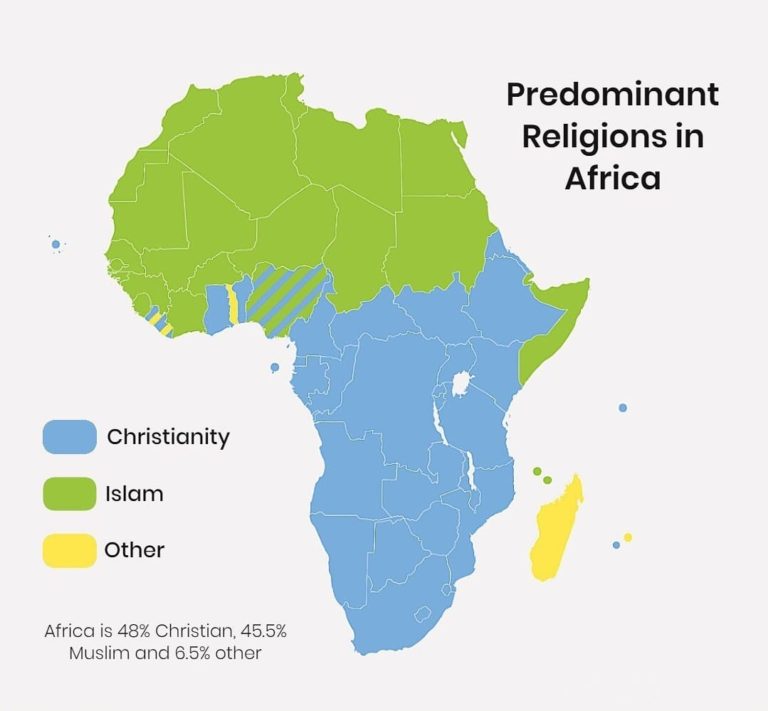
Predominant Religions in Africa RR Power School
When looking at a map of religions in Africa, it's clear that there are many different types of beliefs found in this continent. By studying the Africa religions map below, we see that the large religions seem to be Christianity and Islam, with some smaller religions scattered throughout, such as traditional African religions and Hinduism.

based on the map of religon, the religion that is most practiced in the southern part of Africa
Pin Tweet Filed Under: Want to understand religion in Africa? Then the map above is a good place to start. Basically, Islam dominates the North and East of the continent, while Christianity dominates the South and West, while other native and folk religions can be found scattered throughout.

These are all the world's major religions in one map World Economic Forum
African Association for the Study of Religions (via University of Leeds, UK) The site includes information about conferences and members' activities. "The AASR was founded at an International Association for the History of Religions Regional Conference at the University of Zimbabwe at Harare, Zimbabwe, in September 1992.
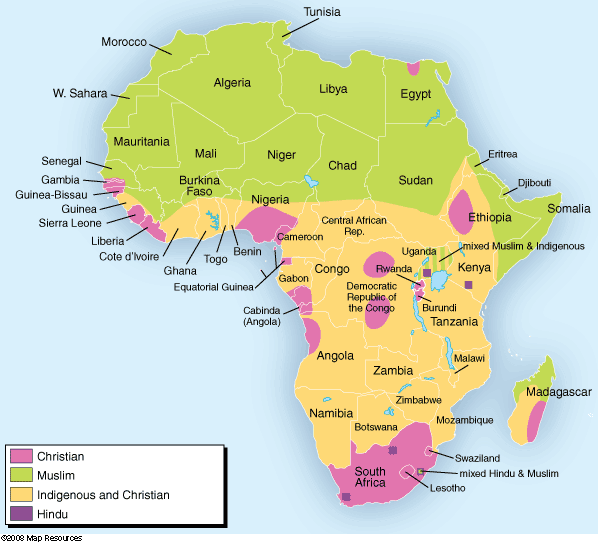
Unit 1 Islam
Map showing different Regions and their predominant religion ( source) ANCIENT BELIEFS Africa has no single body of religious practice and belief that can be identified with the continent. Although religion in Africa is quite multifaceted, it has had a great effect on the art, culture, and philosophy of the African people.